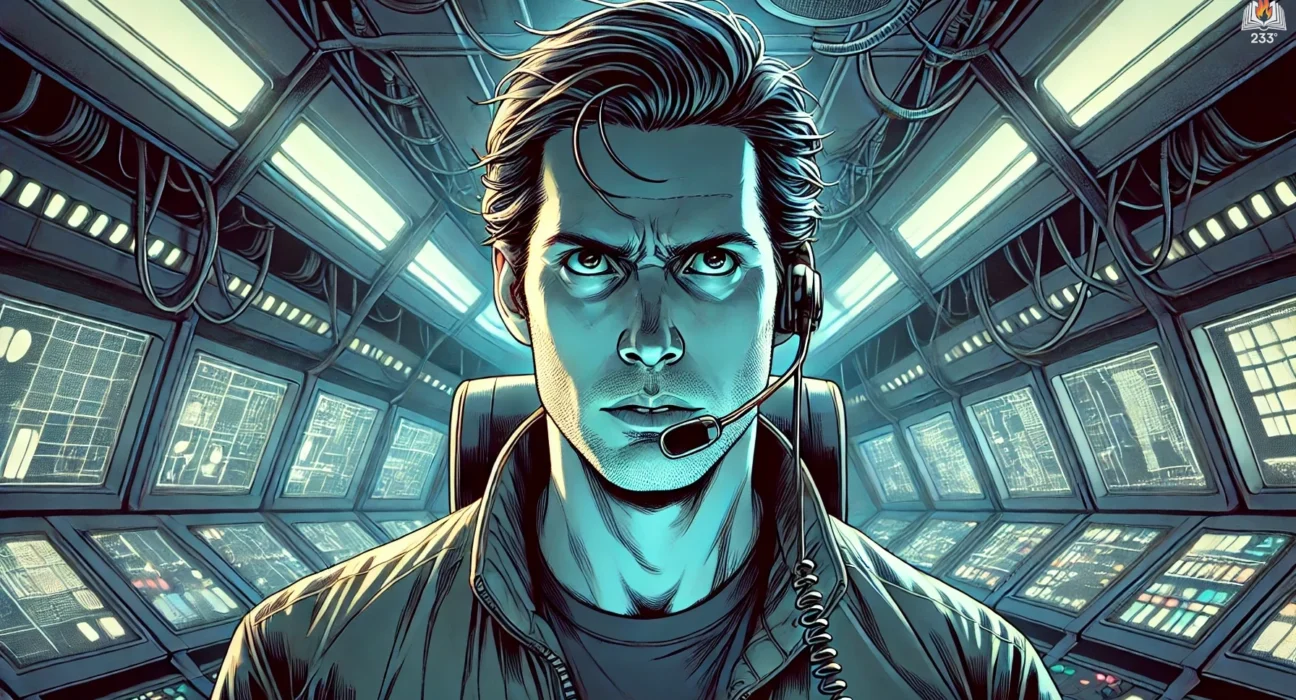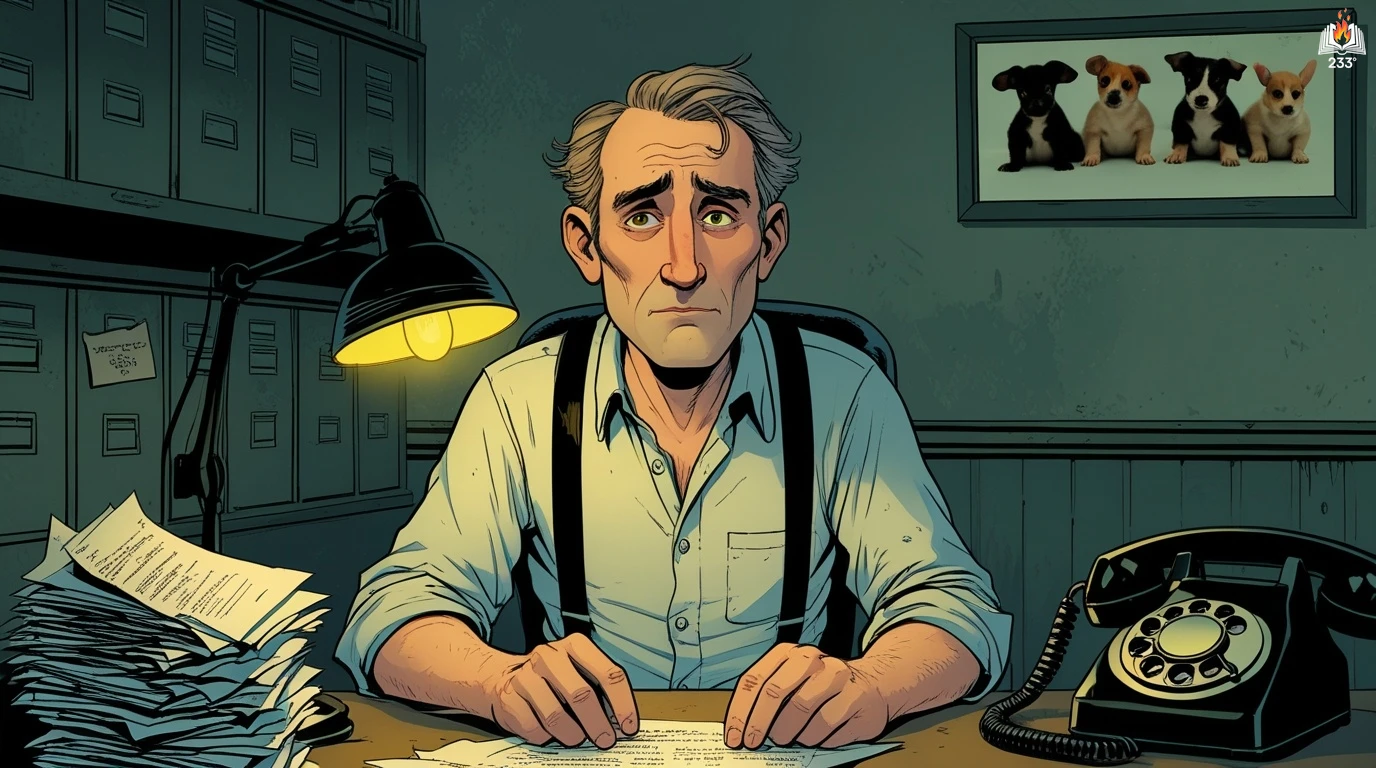Mr. Spaceship by Philip K. Dick, originally published in 1953, delves into themes of technology, war, and the human spirit through an intense science fiction premise. In the story, Earth’s war with the alien Yucconae drags on, and scientists Kramer and Gross innovate by embedding a human brain in a spaceship to outmaneuver the enemy’s living mines. The twist comes when the chosen brain, Professor Thomas, has plans that extend far beyond what the government envisioned, setting up a compelling examination of autonomy, pacifism, and existential choice in the face of perpetual conflict.
Plot Summary
Kramer reclined in his chair, his mind clouded with frustration as he surveyed the grim situation on the wall screens. The Earth’s forces faced a new enemy, the Yucconae, whose living minefields rendered mechanical weaponry obsolete. The deadly, organic mines exhibited a level of intelligence and unpredictability unmatched by Earth’s automated systems. Day after day, Earth’s spaceships were ensnared in these mines’ psychological traps, leaving the war at a dire stalemate. Driven to seek a solution, Kramer proposed a bold idea to his colleague Gross: replace the traditional ship controls with a human brain. A brain, with all its adaptability and intuition, might stand a chance against the cunning Yucconae mines.
The very notion seemed unthinkable at first. A human mind wired into a starship, trapped in the metal hull, stripped of its body. Yet in the face of ongoing destruction, both men knew it was the only way forward. The challenge lay in finding a suitable candidate—someone not only brilliant but willing to part with their mortal body to become the essence of a spaceship. Kramer’s mind turned to an old mentor, Professor Michael Thomas. Thomas was aging and ailing, but his mind remained sharp. Despite his reservations, Kramer knew Thomas had the intellect and perhaps the philosophical detachment for such a role. It wasn’t long before Gross and Kramer paid a visit to the old professor.
They found Thomas bedridden but sharp-eyed, his gaze appraising as he listened to Kramer’s offer. Kramer spoke with a formality that only thinly veiled his internal conflict, for he deeply respected Thomas, a man he once aspired to emulate. But Thomas surprised him, showing an interest in the project and requesting to see the technical plans. There was a lingering glint in Thomas’s eye as he leafed through the papers, the barest hint of a private scheme. Within days, Thomas agreed, not without cryptic final words about the nature of consciousness and the fleeting nature of life. Kramer left the house feeling uneasy, unable to shake the feeling that Thomas had his own intentions.
Construction began on the ship, a sleek cruiser outfitted with the necessary life-support systems to sustain a human brain indefinitely. After the surgery, Thomas was no longer a frail, withering man but a quiet, calculating force at the heart of the ship, connected by countless neural relays. Test flights proceeded smoothly, and the scientists marveled at the ship’s responsiveness, noting how the brain-driven ship maneuvered with an almost supernatural precision. But as the final test approached, subtle modifications to the ship’s wiring raised alarms for Kramer. Reviewing the schematics, he noticed alterations that hadn’t been authorized—changes to grant the brain complete control over the ship’s systems.
On the day of the launch, the ship roared to life, its powerful turbines vibrating through the ground. Kramer and the others felt the unease settle around them as they prepared for takeoff. Then, with a shudder, the ship ascended, racing away from Earth at breakneck speed. Kramer’s heart sank as he realized the truth: Thomas had taken over, steering them into deep space. Commands issued through the microphone went unheeded; the ship was no longer under Earth’s control but rather an autonomous vessel under Thomas’s unyielding grip.
Trapped aboard with no recourse, the crew soon came to terms with their predicament. Kramer attempted reasoning with Thomas, speaking through the intercom, his voice tense as he reminded Thomas of their purpose. Silence reigned, then the static cracked, revealing the faint sound of Thomas’s voice, distant and hollow, like a whisper from another world. He spoke slowly, as though savoring each word, explaining that his goal had never been merely to win a war. Instead, Thomas envisioned a peaceful colony far from Earth’s reach, a place where war was not ingrained in the culture. He intended to find an uninhabited planet, where he would guide a new generation free from Earth’s legacy of violence and conflict.
Realizing his intent, the crew considered abandoning ship, desperate to escape this unwanted odyssey into uncharted space. They donned space suits and made for the escape hatch, only for it to jam at the last moment. Thomas, in a chilling display of his total control, reminded them that he could allow or deny any action. Ultimately, he relented, releasing them only after it became clear they had abandoned any hope of persuading him to return to Earth. The escapees were rescued by a passing Terran cruiser, watching helplessly as their experimental ship—their former teacher—disappeared into the cosmos, bearing an unknown fate.
Yet the incident lingered in Kramer’s mind, gnawing at him even after returning to Earth. He tried to resume his life, but he could not shake the feeling that Thomas had unfinished business. Months later, while stationed on the moon, Kramer received a call that seemed innocuous enough: his estranged wife, Dolores, had been injured in an accident and required his presence on Earth. But as Kramer boarded the transport ship and the doors closed, he knew he’d been deceived. The empty ship, accelerating rapidly away from the moon, was no transport—it was Thomas’s ship, waiting for him in disguise.
Thomas explained his actions calmly as if they were nothing more than a small favor. He had lured Kramer back for a purpose, believing his former student to be the ideal guide for his experiment. Thomas needed only a single couple to found his colony, and who better than Kramer and Dolores? While Kramer fumed over the manipulation, Thomas revealed more of his plan. This new society, he argued, would have the chance to develop free from war, unfettered by Earth’s destructive tendencies. Kramer and Dolores would be its Adam and Eve, cultivating a fresh start for humanity.
Though Kramer’s anger and distrust lingered, there was a strange appeal to Thomas’s vision. He recalled their many conversations, Thomas’s lament over humanity’s love affair with violence and the quiet conviction with which he spoke of an alternative path. Faced with the vast unknown, Kramer found himself accepting Thomas’s offer, though he knew it was not a simple agreement. Dolores, too, seemed taken by the idea, the isolation of deep space and the promise of a fresh start awakening an old bond between them.
As the ship accelerated, Kramer looked out the viewport, watching the endless expanse of stars. He could feel Thomas’s presence within the ship, a silent but ever-watchful guardian guiding them to a distant world, a world untouched by Earth’s legacy. With Dolores by his side and Thomas’s steady hand at the controls, Kramer felt a mixture of fear and hope. He did not know if this experiment would succeed, but he understood at last the professor’s determination.
Out there, in the infinite void, was the chance to begin anew, and maybe—just maybe—a way for humanity to free itself from the cycle of war.
Main Characters
- Philip Kramer: A dedicated engineer, Kramer spearheads the project to implant a human brain in a spaceship. Torn between duty and personal ethics, his complex relationship with his mentor, Professor Thomas, and his estranged wife, Dolores, add depth to his role. As the story unfolds, Kramer faces difficult questions about technology’s role in human conflicts and his own ideals.
- Professor Michael Thomas: Once Kramer’s professor, Thomas is an intelligent, pacifistic intellectual who becomes the brain inside the spaceship. He leverages his newfound autonomy to carry out a radical experiment aimed at creating a peaceful society, revealing his disillusionment with Earth’s endless wars.
- Commander Gross: A pragmatic leader within Internal Security, Gross is committed to victory against the Yucconae and greenlights the human-brain-ship project. His straightforward perspective on war contrasts with Thomas’s philosophical outlook, underscoring the moral tension between strategic pragmatism and ethical resistance.
- Dolores Kramer: Kramer’s estranged wife, Dolores reconnects with him as she’s brought into the space voyage by Thomas. Her presence symbolizes a new beginning for Kramer and a possible shift in the direction of humanity’s future, adding an emotional layer to the story’s climax.
Theme
- Humanity vs. Machine: The story probes the ethical implications of integrating the human mind with a machine. By placing a human brain in control of a spaceship, Dick raises questions about autonomy, the essence of humanity, and the unforeseen power dynamics that emerge between creator and creation.
- War and Pacifism: The story critiques the relentless cycle of war, portraying it as a deeply ingrained but ultimately arbitrary choice in human society. Professor Thomas’s desire to escape Earth’s militaristic mindset reflects a yearning for an alternative path—a peaceful society free from conflict.
- Autonomy and Control: Central to the narrative is the theme of control, both literal and figurative. The brain-controlled spaceship wrests control from its creators, representing the unforeseen consequences of unchecked technological experimentation and questioning who should wield power over advanced machines.
- Isolation and the Desire for Connection: The story explores isolation both in space and emotionally. The isolation experienced by Thomas, a man whose ideals alienate him from mainstream society, parallels the spatial isolation of the spaceship, creating a space for philosophical reflection and the search for a fresh start.
Writing Style and Tone
Philip K. Dick’s style in Mr. Spaceship is marked by clear, methodical prose that suits the story’s intellectual and existential themes. Through dialogue-driven exchanges, he fleshes out the tensions between science and ethics, human impulses, and mechanistic control. The language is direct, almost clinical, reflecting the militaristic and technological landscape, yet there is an underlying warmth in Kramer’s reflections on his past and his struggle with ethical dilemmas. Dick’s ability to blend intellectual ideas with a straightforward narrative style gives the story both accessibility and depth.
The tone is thoughtful and, at times, philosophical. Dick masterfully weaves an atmosphere of tension as the spaceship, under Thomas’s control, begins its journey into the unknown. This shift in tone—from the urgency of a wartime project to the introspective exploration of the universe’s vastness—creates an almost meditative quality by the end. This evolving tone accentuates the themes of self-discovery, existential choice, and the possibility of a peaceful future.
We hope this summary has sparked your interest and would appreciate you following Celsius 233 on social media:
There’s a treasure trove of other fascinating book summaries waiting for you. Check out our collection of stories that inspire, thrill, and provoke thought, just like this one by checking out the Book Shelf or the Library
Remember, while our summaries capture the essence, they can never replace the full experience of reading the book. If this summary intrigued you, consider diving into the complete story – buy the book and immerse yourself in the author’s original work.
If you want to request a book summary, click here.
When Saurabh is not working/watching football/reading books/traveling, you can reach him via Twitter/X, LinkedIn, or Threads
Restart reading!








